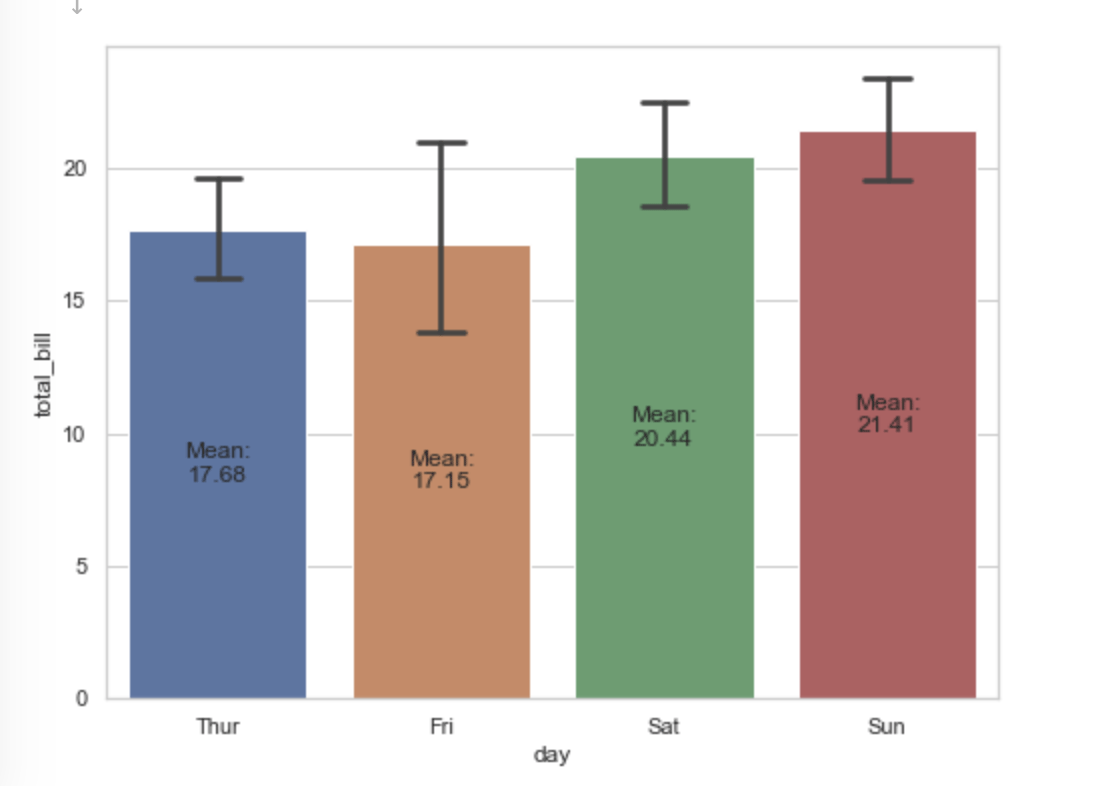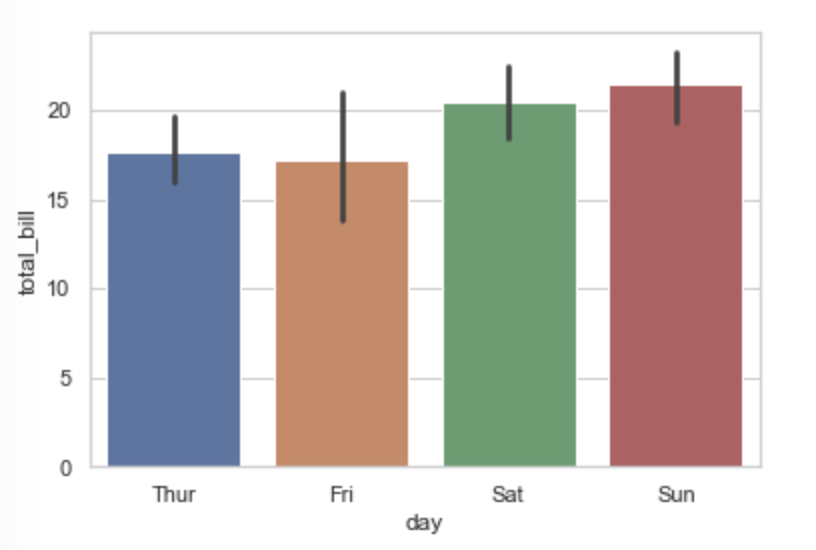Python seaborn barplot画图案例
目录
- 默认barplot
- 使用案例
- 修改capsize
- 显示error bar的值
- annotata error bar
- error bar选取sd
- 设置置信区间(68)
- 设置置信区间(95)
- dataframe aggregate函数使用
- dataframe aggregate 自定义函数
- dataframe aggregate 自定义函数2
- seaborn显示网格
- seaborn设置刻度
- 使用其他estaimator
默认barplot
import seaborn as sns
import matplotlib.pyplot as plt
import numpy as np
sns.set_theme(style="whitegrid")
df = sns.load_dataset("tips")
#默认画条形图
sns.barplot(x="day",y="total_bill",data=df)
plt.show()
#计算平均值看是否和条形图的高度一致
print(df.groupby("day").agg({"total_bill":[np.mean]}))
print(df.groupby("day").agg({"total_bill":[np.std]}))
# 注意这个地方error bar显示并不是标准差

total_bill
mean
day
Thur 17.682742
Fri 17.151579
Sat 20.441379
Sun 21.410000
total_bill
std
day
Thur 7.886170
Fri 8.302660
Sat 9.480419
Sun 8.832122
使用案例
# import libraries
import seaborn as sns
import numpy as np
import matplotlib.pyplot as plt
# load dataset
tips = sns.load_dataset("tips")
# Set the figure size
plt.figure(figsize=(14, 8))
# plot a bar chart
ax = sns.barplot(x="day", y="total_bill", data=tips, estimator=np.mean, ci=85, capsize=.2, color='lightblue')

修改capsize
ax=sns.barplot(x="day",y="total_bill",data=df,capsize=1.0) plt.show()

显示error bar的值
import seaborn as sns
import matplotlib.pyplot as plt
sns.set_theme(style="whitegrid")
df = sns.load_dataset("tips")
#默认画条形图
ax=sns.barplot(x="day",y="total_bill",data=df)
plt.show()
for p in ax.lines:
width = p.get_linewidth()
xy = p.get_xydata() # 显示error bar的值
print(xy)
print(width)
print(p)

[[ 0. 15.85041935] [ 0. 19.64465726]] 2.7 Line2D(_line0) [[ 1. 13.93096053] [ 1. 21.38463158]] 2.7 Line2D(_line1) [[ 2. 18.57236207] [ 2. 22.40351437]] 2.7 Line2D(_line2) [[ 3. 19.66244737] [ 3. 23.50109868]] 2.7 Line2D(_line3)
annotata error bar
fig, ax = plt.subplots(figsize=(8, 6))
sns.barplot(x='day', y='total_bill', data=df, capsize=0.2, ax=ax)
# show the mean
for p in ax.patches:
h, w, x = p.get_height(), p.get_width(), p.get_x()
xy = (x + w / 2., h / 2)
text = f'Mean:\n{h:0.2f}'
ax.annotate(text=text, xy=xy, ha='center', va='center')
ax.set(xlabel='day', ylabel='total_bill')
plt.show()

error bar选取sd
import seaborn as sns
import matplotlib.pyplot as plt
sns.set_theme(style="whitegrid")
df = sns.load_dataset("tips")
#默认画条形图
sns.barplot(x="day",y="total_bill",data=df,ci="sd",capsize=1.0)## 注意这个ci参数
plt.show()
print(df.groupby("day").agg({"total_bill":[np.mean]}))
print(df.groupby("day").agg({"total_bill":[np.std]}))

total_bill
mean
day
Thur 17.682742
Fri 17.151579
Sat 20.441379
Sun 21.410000
total_bill
std
day
Thur 7.886170
Fri 8.302660
Sat 9.480419
Sun 8.832122
设置置信区间(68)
import seaborn as sns
import matplotlib.pyplot as plt
sns.set_theme(style="whitegrid")
df = sns.load_dataset("tips")
#默认画条形图
sns.barplot(x="day",y="total_bill",data=df,ci=68,capsize=1.0)## 注意这个ci参数
plt.show()

设置置信区间(95)
import seaborn as sns
import matplotlib.pyplot as plt
sns.set_theme(style="whitegrid")
df = sns.load_dataset("tips")
#默认画条形图
sns.barplot(x="day",y="total_bill",data=df,ci=95)
plt.show()
#计算平均值看是否和条形图的高度一致
print(df.groupby("day").agg({"total_bill":[np.mean]}))

total_bill
mean
day
Thur 17.682742
Fri 17.151579
Sat 20.441379
Sun 21.410000
dataframe aggregate函数使用
#计算平均值看是否和条形图的高度一致
df = sns.load_dataset("tips")
print("="*20)
print(df.groupby("day").agg({"total_bill":[np.mean]})) # 分组求均值
print("="*20)
print(df.groupby("day").agg({"total_bill":[np.std]})) # 分组求标准差
print("="*20)
print(df.groupby("day").agg({"total_bill":"nunique"})) # 这里统计的是不同的数目
print("="*20)
print(df.groupby("day").agg({"total_bill":"count"})) # 这里统计的是每个分组样本的数量
print("="*20)
print(df["day"].value_counts())
print("="*20)
====================
total_bill
mean
day
Thur 17.682742
Fri 17.151579
Sat 20.441379
Sun 21.410000
====================
total_bill
std
day
Thur 7.886170
Fri 8.302660
Sat 9.480419
Sun 8.832122
====================
total_bill
day
Thur 61
Fri 18
Sat 85
Sun 76
====================
total_bill
day
Thur 62
Fri 19
Sat 87
Sun 76
====================
Sat 87
Sun 76
Thur 62
Fri 19
Name: day, dtype: int64
====================
dataframe aggregate 自定义函数
import numpy as np
import pandas as pd
df = pd.DataFrame({'Buy/Sell': [1, 0, 1, 1, 0, 1, 0, 0],
'Trader': ['A', 'A', 'B', 'B', 'B', 'C', 'C', 'C']})
print(df)
def categorize(x):
m = x.mean()
return 1 if m > 0.5 else 0 if m < 0.5 else np.nan
result = df.groupby(['Trader'])['Buy/Sell'].agg([categorize, 'sum', 'count'])
result = result.rename(columns={'categorize' : 'Buy/Sell'})
result
Buy/Sell Trader 0 1 A 1 0 A 2 1 B 3 1 B 4 0 B 5 1 C 6 0 C 7 0 C

dataframe aggregate 自定义函数2
df = sns.load_dataset("tips")
#默认画条形图
def custom1(x):
m = x.mean()
s = x.std()
n = x.count()# 统计个数
#print(n)
return m+1.96*s/np.sqrt(n)
def custom2(x):
m = x.mean()
s = x.std()
n = x.count()# 统计个数
#print(n)
return m+s/np.sqrt(n)
sns.barplot(x="day",y="total_bill",data=df,ci=95)
plt.show()
print(df.groupby("day").agg({"total_bill":[np.std,custom1]})) # 分组求标准差
sns.barplot(x="day",y="total_bill",data=df,ci=68)
plt.show()
print(df.groupby("day").agg({"total_bill":[np.std,custom2]})) #
[外链图片转存失败,源站可能有防盗链机制,建议将图片保存下来直接上传(img-pkCx72ui-1658379974318)(output_24_0.png)]
total_bill
std custom1
day
Thur 7.886170 19.645769
Fri 8.302660 20.884910
Sat 9.480419 22.433538
Sun 8.832122 23.395703
[外链图片转存失败,源站可能有防盗链机制,建议将图片保存下来直接上传(img-GFyIePmW-1658379974318)(output_24_2.png)]
total_bill
std custom2
day
Thur 7.886170 18.684287
Fri 8.302660 19.056340
Sat 9.480419 21.457787
Sun 8.832122 22.423114
seaborn显示网格
ax=sns.barplot(x="day",y="total_bill",data=df,ci=95) ax.yaxis.grid(True) # Hide the horizontal gridlines ax.xaxis.grid(True) # Show the vertical gridlines

seaborn设置刻度
fig, ax = plt.subplots(figsize=(10, 8)) sns.barplot(x="day",y="total_bill",data=df,ci=95,ax=ax) ax.set_yticks([i for i in range(30)]) ax.yaxis.grid(True) # Hide the horizontal gridlines

使用其他estaimator
#estimator 指定条形图高度使用相加的和
sns.barplot(x="day",y="total_bill",data=df,estimator=np.sum)
plt.show()
#计算想加和看是否和条形图的高度一致
print(df.groupby("day").agg({"total_bill":[np.sum]}))
'''
total_bill
sum
day
Fri 325.88
Sat 1778.40
Sun 1627.16
Thur 1096.33
'''

到此这篇关于Python seaborn barplot画图案例的文章就介绍到这了,更多相关Python seaborn barplot 内容请搜索我们以前的文章或继续浏览下面的相关文章希望大家以后多多支持我们!
赞 (0)

